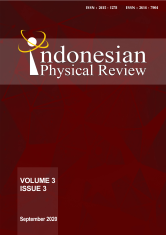REACTION MODEL TO PREDICT THE THERMAL DEGRADATION MECHANISM OF POLYPROPYLENE – CARBON NANOTUBE COMPOSITE
DOI:
10.29303/ipr.v3i3.62Downloads
Abstract
The degradation of polymer is known, but the effect of CNT composite is the less studied concept. In this article, the effect of CNT on degradation is presented. The first stage involved a literature study for reaction mechanisms in oxidative thermal degradation of Polypropylene (PP). A reaction model is then developed by considering mass balance on various reactive species. Literature is reviewed to find or estimate the model parameters. The parameters not found in the literature are fitted. The model equations are solved after assuming initial conditions and values of various parameters. After the PP polymer degradation modeling comparison drown between PP and PP/MWCNT composite by making a hypothesis based on Arrhenius equations (activation energy increases, the rate constant decreases, and therefore the rate of reaction decreases). The result shows that the CNT composite takes much time to degrade as compared to the polymer.Keywords:
Polypropylene CNT composite Degradation PP/MWCNTReferences
P. C. P. Watts, P. K. Fearon, W. K. Hsu,* N. C. Billingham, H. W. Kroto and D. R. M. Walton, Carbon nanotubes as polymer antioxidants, J. Mater. Chem., 2003, 13, 491–495, doi: 10.1039/b211328g
G. E. Zaikov , A. D. Rakhimkulov , S. M. Lomakin , I. L. Dubnikova , A. N. Shchegolikhin , E. Ya. Davidov & R. Kozlowski (2010) Thermal Degradation and Combustion Behavior of Polypropylene/MWCNT Composites, Molecular Crystals and Liquid Crystals,523:1, 106/[678]-119/ [691], doi: 10.1080/15421401003726543
Supan KE, Robert C, Miller MJ, Warrender JM, Bartolucci SF, Thermal degradation of MWCNT/polypropylene nanocomposites: A comparison of TGA and laser pulse heating, Polymer Degradation and Stability (2017), doi:10.1016/j.polymdegradstab.2017.05.006.
H. K. F. Cheng, M. F. Chong, E. Liu, K. Zhou, L. Li, J Therm Anal Calorim doi 10.1007/s10973-014-3668-8
Chapter 3, Gugumus, F. “General introduction of polypropylene†in "Plastic Additives Handbook", eds. Gachter, R.(Editor) & Moller.(Editor),Hanser publishers., New York, 1990:1- 104
Reich L, Stivala S. “Autoxidation of hydrocarbons and polyolefins: Kinetics and Mechanismsâ€, Marcel Dekker, New York, 1969.
Bolland JL, Gee G. “Kinetic studies in the chemistry of rubber and related materials. II. The kinetics of oxidation of unconjugated olefinsâ€, Transaction of the Faraday Society, 42, 1946, 236-243
Gillen KT, Wise J, Clough RL. “General solution for the basic autoxidation schemeâ€, Polymer Degradation and Stability, 47(1), 1995, 149-161
Blanksby SJ, Elision GB. “Bond dissociation Engergies of Organic Molecules†Accounts of Chemical Research, American Chemical society, 36(4), 2003, 255-263.
Rincon-Rubio L.M., Fayolle B., Audouin L., Verdu J. “A general solution of the closed-loop kinetic scheme for the thermal oxidation of polypropyleneâ€, Polymer Degradation and Stability, 74(1), 2001, 177–188.
Verdu S, Verdu J. “A New Kinetic Model for Polypropylene Thermal Oxidation at Moderate Temperaturesâ€, Macromolecules, 30(8), 1997, 2262-2267.
Thermal degradation of polymer–carbon nanotube composites, S. P. SU, Y. H. XU,P. R. China and C. A. WILKIE
H. M. Ng, Norshahirah M. Saidi, Fatin Saiha Omar, K. Ramesh, S. Ramesh, Thermogravimetric analysis of polymers,doi: 10.1002/0471440264.pst667
Lankone, R. S., Wang, J., Ranville, J. F., & Fairbrother, D. H. (2017). Photodegradation of polymer-CNT nanocomposites: effect of CNT loading and CNT release characteristics. Environmental Science: Nano, 4(4), 967–982. doi:10.1039/c6en00669h
License
Authors who publish with Indonesian Physical Review Journal, agree to the following terms:
- Authors retain copyright and grant the journal right of first publication with the work simultaneously licensed under a Creative Commons Attribution-ShareAlike 4.0 International Licence (CC BY SA-4.0). This license allows authors to use all articles, data sets, graphics, and appendices in data mining applications, search engines, web sites, blogs, and other platforms by providing an appropriate reference. The journal allows the author(s) to hold the copyright without restrictions and will retain publishing rights without restrictions.
- Authors are able to enter into separate, additional contractual arrangements for the non-exclusive distribution of the journal's published version of the work (e.g., post it to an institutional repository or publish it in a book), with an acknowledgment of its initial publication in Indonesian Physical Review Journal.
- Authors are permitted and encouraged to post their work online (e.g., in institutional repositories or on their website) prior to and during the submission process, as it can lead to productive exchanges, as well as earlier and greater citation of published work (See The Effect of Open Access).





